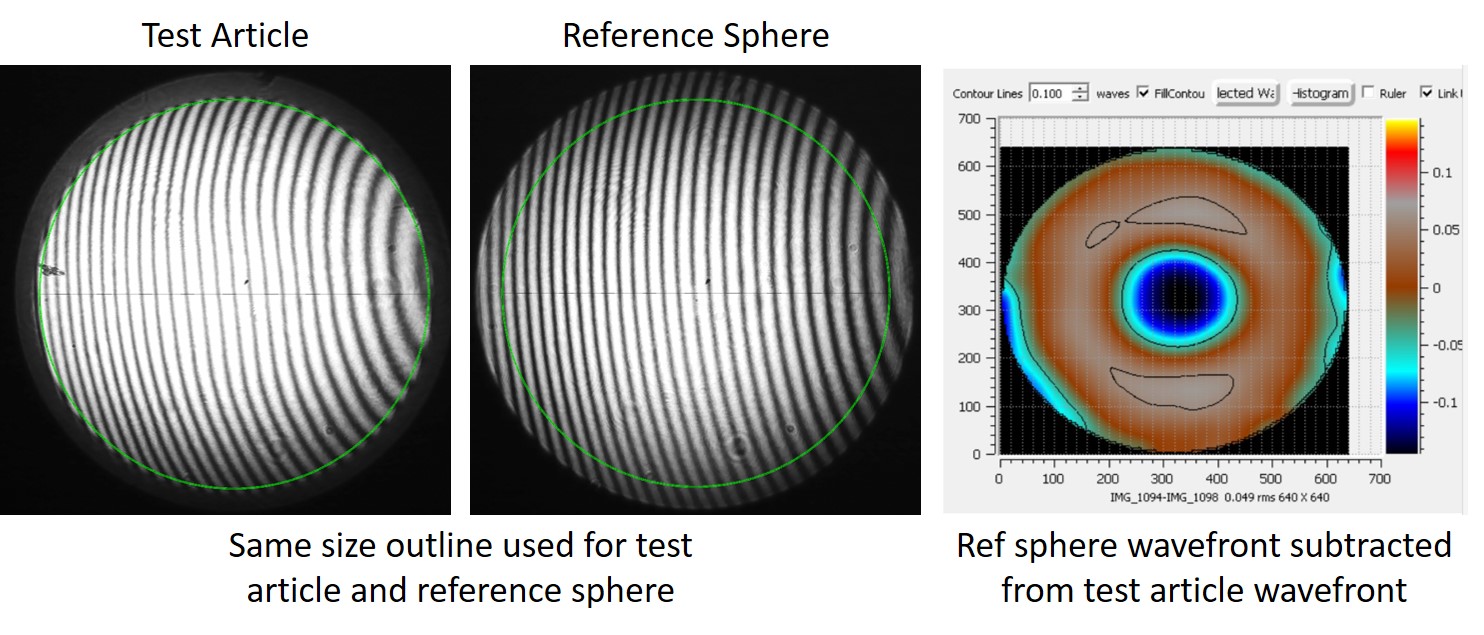Although the SPPDI unit itself is rugged, engaging in interferometric measurements can be challenging. As with any optical interferometer, operation of the SPPDI requires a stable, vibration-free environment with low ambient temperature variations. In addition, a successful interferometric setup requires that the SPPDI and the optical system under test be mounted in stable optical mounts with precision angle and linear motion adjusters.
There are optical benches (mounting platforms) and optical component mounts available from a variety of suppliers which offer the required degree of precise motion control. A web search will quickly reveal a variety of suppliers which serve this market. Alternatively, there are surplus equipment suppliers that offer used equipment obtained from large governmental or commercial laser labs, for a fraction of the cost of new equipment.
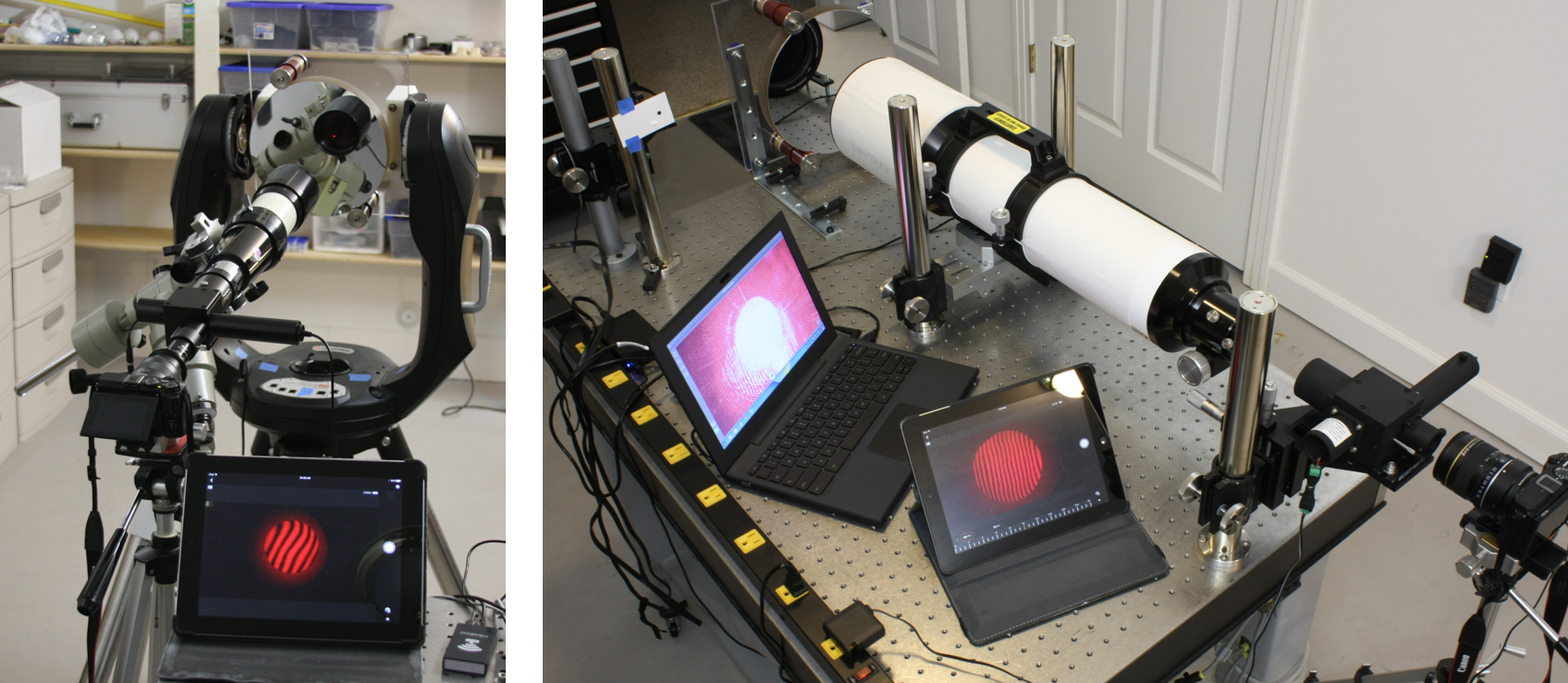 A 2-inch diameter Telescope Adapter is provided with the SPPDI to facilitate direct attachment of the SPPDI to the 2″ eyepiece holder typically provided with higher-end commercial telescopes. Such an arrangement is shown in the photo on the left.
A 2-inch diameter Telescope Adapter is provided with the SPPDI to facilitate direct attachment of the SPPDI to the 2″ eyepiece holder typically provided with higher-end commercial telescopes. Such an arrangement is shown in the photo on the left.
For larger refractors, such as the 5″ refractor shown in the photo on the right, the prime (far-field) focal plane for the telescope objective is so far distant from the rear of the scope that two extension tubes are required in order to position the SPPDI at prime focus. This does not lend itself to precise positioning of the SPPDI with respect to the optical axis of the objective lens. Use of the diagonal mirror eyepiece holder typically provided with these telescopes would enable prime focus to be reached without the use of extenders, but could compound the errors in the objective lens with errors in the diagonal mirror.
So, to avoid these complications, the SPPDI is mounted separately on a three-axis translation stage setup as shown in the photo on the right. This requires that the telescope first be brought into autocollimation with the “optical flat” (high precision flat mirror) used for double-pass interferometry. This is easily accomplished by means of a low cost laser alignment tool typically sold for the purpose of aligning the primary mirror in Newtonian type telescopes. Then the SPPDI is positioned along the x, y, and z axes by means of the translation stages. For reflector type telescopes with low-profile focusers, the SPPDI may be easily positioned at prime focus. Note that the SPPDI pinhole aperture is located at a depth of about 32.5 mm inside the SPPDI enclosure.
As the telescope focal length increases, isolation from ambient vibration becomes increasingly difficult. It is very helpful to have all equipment co-located on a stable platform, such as on an optical table like the one shown in the photo on the right.
The 10″ optical flat seen in the photo above left is mounted in a fork mount obtained by disassembling a large (11″ aperture) commercial Schmidt-Cassegrain type telescope. The optical tube assembly was replaced with a purpose-built saddle capable of supporting a 12-inch diameter optical flat. The electronic slow motion control associated with the fork mount is used to bring the telescope under test into near autocollimation against the optical flat. Final precision alignment is achieved by means of a set of three 1/4×20 jack screws mounted on the ends of three long lever arms which support and raise and lower the tripod feet.
Measurement Methods and Use-Cases
1.) CoC: Center of Curvature.
This use-case is for concave reflective optics, such as parabolic mirrors. Mirrors with focal ratios (“speeds”) as fast as f/2 may be measured directly by the SPPDI without any ancillary optics interposed between the test article and the SPPDI. For example, an f/2 mirror intended for use on remote objects (e.g., planets or stars) will produce an f/4 beam when measured at its center of curvature.
The standard SPPDI will directly accept an f/4 beam. No external beam expansion optics are required to achieve this. Since no beam expansion optics are required, there will be no retrace errors, such as would occur if a microscope objective or Barlow lens were located in the beam path.
On the other hand, unavoidable aberrations (in addition to the spherical aberration expected from an aspheric primary mirror measured at its center of curvature) will occur within the SPPDI internal optics. These aberrations increase exponentially with “faster” test beams. Fortunately, these internal aberrations are easily measured and compensated for by use of a high precision concave spherical reference mirror.
Two very “fast” (f/0.5 and f/1.27) 2″ diameter high precision (<1/10th wave) fused silica concave spherical mirrors are available from Kerry Optical Systems for use in measuring and compensating for the SPPDI internal aberrations. A wavefront obtained for the reference mirror, at the same focal ratio as for the parabolic test article, may be subtracted from the wavefront of the test article, to yield a high accuracy wavefront map for the test article.
The remaining spherical aberration expected when measuring a parabola at its CoC can be artifically nulled by the use of DFTFringe software. This will allow figuring errors to be detected and removed during final polishing stages of the mirror.
As an example, the following interferogram on the left is of a small low-quality f/2 concave spherical mirror measured at its f/4 CoC. (No external optics were used to modify the focal ratio of the f/4 beam entering the SPPDI.) The center interferogram is of a high precision f/1.25 spherical reference mirror measured directly at its f/2.5 CoC. Note that the same green outline is used for processing both interferograms. Note also that the full image of the reference sphere interferogram is vignetted by the maximum aperture of the 50 mm f.l. f/1.4 camera lens used to obtain these interferograms. The wavefront obtained for the high precision reference mirror is subtracted from the wavefront of the test article, yielding a wavefront for the test article that is free of the aberrations inherent in the SPPDI internal optics. The corrected wavefront for the test article indicates that this mirror has a high level of uncorrected spherical aberration.
It should be noted that these interferograms exhibit strong defocus. In this case, the mode structure of the inexpensive laser used with this SPPDI unit was quite poor, making it difficult to achieve a uniform focused point spread function on the SPPDI pinhole aperture. So, the SPPDI was moved slightly away from best focus. Defocus will cause a slight error in the measured value of the spherical aberration, but this can be reduced or eliminated if the reference sphere is defocused by about the same amount.
2.) DPAC: Double-pass At Autocollimation.
This use-case is applicable for measuring either transmissive optics or reflective optics when an accurate optical flat of sufficient size is available to reflect the output collimated beam back through the test article.
The SPPDI will not accept test beams that are faster then f/4 due to the physical size limitations of various internal components. So, if the test article has a “speed” faster than f/4, it will be necessary to interpose beam expanding optics between the SPPDI and the test article. Microscope objectives work well for this purposes, but will still exhibit various aberrations that need to be measured and compensated for. This can be done with the aid of the Kerry Optical Systems high precision reference mirrors as discussed in the CoC use case.
The process for measuring and compensating for the errors in the beam expanding optics and SPPDI are removed by placing the center of curvature of the reference mirror at the virtual focus of the expanding beam, and then obtaining an interferogram and computing a compensating wavefront at the same focal ratio as for the test article. This compensating wavefront is subtracted from the wavefront for the test article, to yield a wavefront for just the test article itself.
Beam Expanding Optics
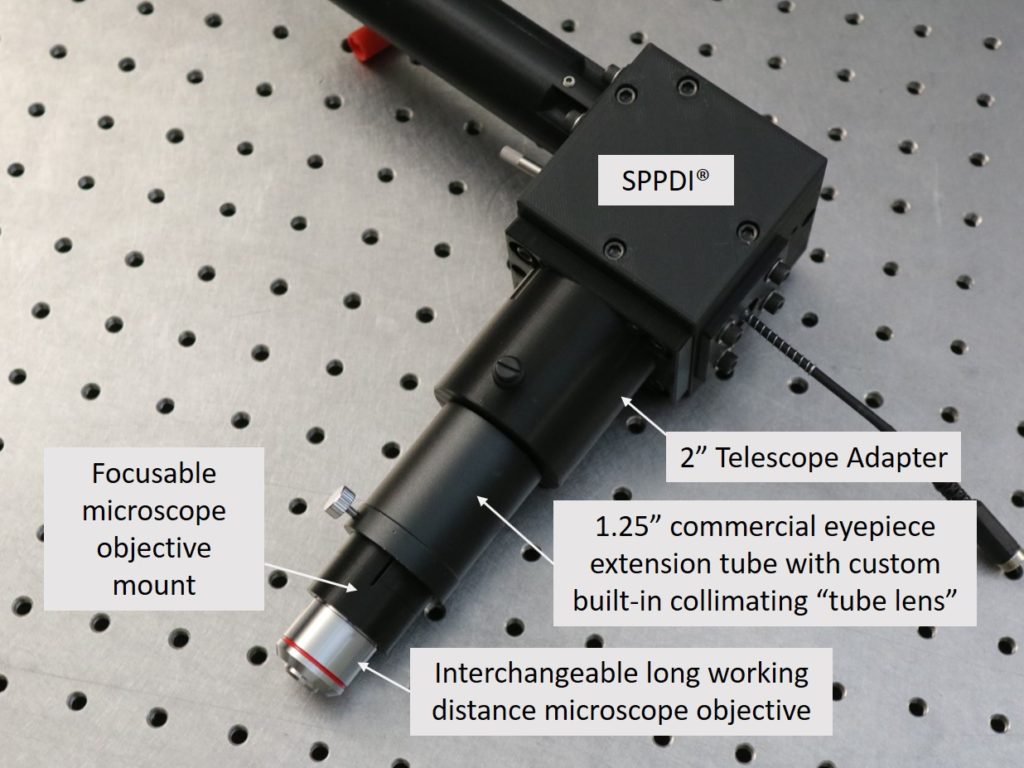 The SPPDI output beam is limited by the physical dimensions of the internal components to a focal ratio of f/4. So, beam expanding optics must be used when the focal ratio of the test beam is “faster” than f/4. This figure shows the components that comprise one type of beam expanding optics that comprise our Tube Lens Collimator and a user-supplied microscope objective. This type of setup is known as a Transmission Sphere.
The SPPDI output beam is limited by the physical dimensions of the internal components to a focal ratio of f/4. So, beam expanding optics must be used when the focal ratio of the test beam is “faster” than f/4. This figure shows the components that comprise one type of beam expanding optics that comprise our Tube Lens Collimator and a user-supplied microscope objective. This type of setup is known as a Transmission Sphere.
The Transmission Sphere comprises two parts: (1) a collimating “tube lens” mounted in the small (1.25″ OD) end of the COTS eyepiece extender; and (2) a compression mount that fits in the eyepiece end of the COTS eyepiece extender. The “tube lens” receives the diverging beam from the SPPDI and collimates the beam to a diameter that just overfills the rear aperture (typically 8 or 9 mm) of interchangeable microscope objectives that screw into the RMS threaded end of the compression mount.
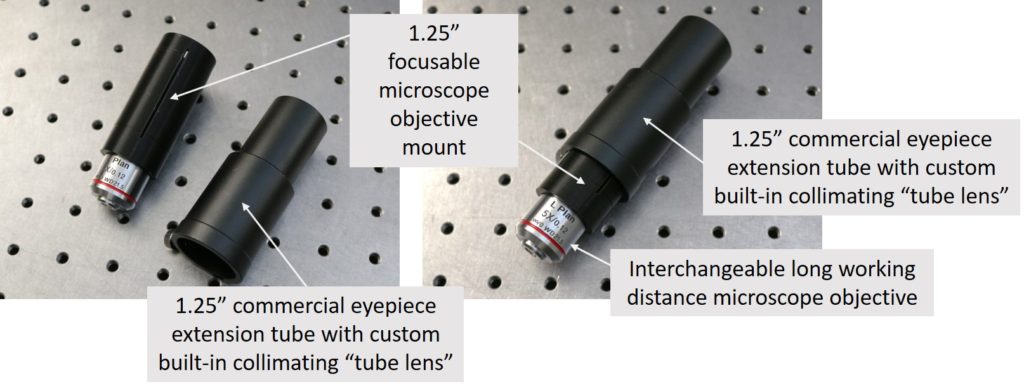 Each microscope objective produces a converging output beam which has a focal ratio governed by the NA (numerical aperture) of the microscope objective. For example, a 10x objective with an NA of 0.25 will produce an output beam from the microscope objective with a focal ratio of f/2. A 5x microscope objective with an NA 0.12 will produce an f/4 output beam. “Faster” output beams can be achieved with higher NA objectives.
Each microscope objective produces a converging output beam which has a focal ratio governed by the NA (numerical aperture) of the microscope objective. For example, a 10x objective with an NA of 0.25 will produce an output beam from the microscope objective with a focal ratio of f/2. A 5x microscope objective with an NA 0.12 will produce an f/4 output beam. “Faster” output beams can be achieved with higher NA objectives.
The Transmission Sphere may be used in combination with either our precision reference mirror or our precision Random Ball Test Kit, to produce a correction wavefront, which can then be subtracted from the wavefront obtained for the test article. This process allows removal of the errors associated with the Transmission Sphere or Random Ball as well as the SPPDI.
Most situations where beam expanding optics are used will require the use of a dedicated “macro” type camera lens in order to focus the camera on the test article. Alternatively, a less expensive close-up or “macro” lens attached to the front of a standard camera lens has been found to give good results.
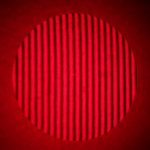 Close-up attachment lenses can produce quite good results as shown in this interferogram of a 4.25 inch diameter 34″ radius concave spherical mirror. This interferogram was obtained with a Transmission Sphere operating at f/8 and a 10x close-up lens attached to the front of an 85 mm focal length f/1.8 telephoto lens.
Close-up attachment lenses can produce quite good results as shown in this interferogram of a 4.25 inch diameter 34″ radius concave spherical mirror. This interferogram was obtained with a Transmission Sphere operating at f/8 and a 10x close-up lens attached to the front of an 85 mm focal length f/1.8 telephoto lens.
The interferogram and associated wavefront for the test article should be obtained first, with a DFTFringe outline that is suitable for the test article. This same outline must then be used in obtaining the correction wavefront from the reference sphere interferogram. This will typically mean that the outline used in producing the wavefront for the reference sphere will be substantially smaller than the full diameter of the reference sphere interferogram.
Wavefront “Sense”
An interferogram is a topographic map of a wavefront. Just as in reading a topographic map of a mountain, it is often difficult to know whether traversing the map from fringe to fringe leads uphill or downhill. For optical interferometry, sophisticated and expensive optics can be introduced in the beam path that eliminates the confusion. Fortunately, there is a very simple method for determining the wavefront “sense” which does not require expensive add-on optics. The method involves defocusing the wavefront, and observing the algebraic sign of the Zernike Z3 Defocus term, as displayed by DFTFringe. If the interferometer has moved closer to the test article, the algebraic sign of the Z3 term should become more negative, but all other Zernike terms should remain approximately the same. If the Z3 term becomes more positive, then the DFTFringe “Invert” function should be launched to invert the defocused wavefront. If the Z8 terms of the defocused and non-defocused wavefronts no longer have the same algebraic sign, then the non-defocused wavefront should be inverted.
![]()

